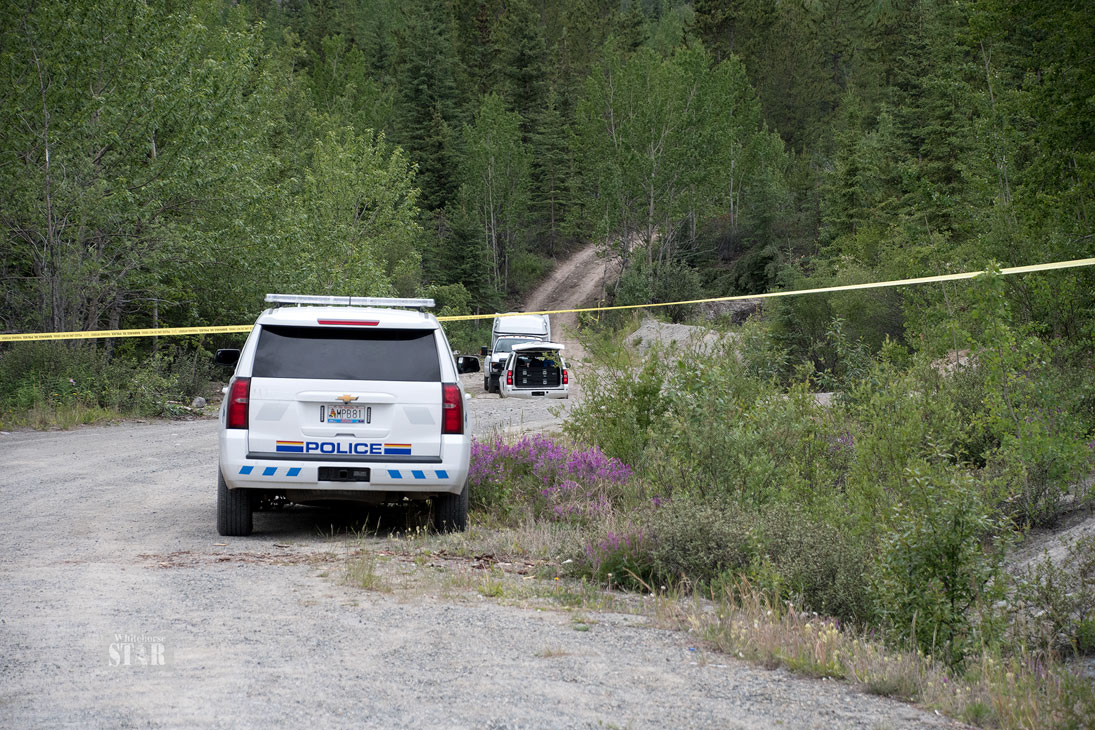
Photo by Whitehorse Star

Photo by Whitehorse Star

Photo by Vince Fedoroff
THE INVESTIGATION ENSUES – RCMP investigators work at the scene of the discovery of Adam Cormack’s body northwest of Whitehorse in June 2017.
The Crown has presented its opening argument in the trial of Edward James Penner, the Quesnel, B.C. man who stands charged with one count of first-degree murder in Whitehorse.
The Crown has presented its opening arguments in the trial of Edward James Penner, the Quesnel, B.C. man who stands charged with one count of first-degree murder in Whitehorse.
Crown prosecutor Amy Porteous gave her opening remarks Wednesday to Yukon Supreme Court Deputy Justice Scott Brooker and a jury.
Penner, 22, is accused of killing 25-year-old Adam Cormack in June 2017 near the old Castle Rock gravel pit northwest of Whitehorse, in the Old Alaska Highway Area.
Porteous said Cormack died from a bullet wound to the head.
She said this killing was deliberate and planned by the accused.
She clarified that only the accused and Cormack saw the shooting.
Porteous described a trial like a puzzle, saying people testifying were not necessarily eyewitnesses to the murder.
She warned that the evidence may be presented in a strange order, but this plays into the puzzle analogy.
She told the jury that on June 28, 2017, a man and his son went to the gravel pit with a metal detector to see what they could find. They discovered Cormack’s body and a man leaving the scene.
Porteous explained that the man observed leaving the scene was identified and interviewed by the RCMP.
This man had also found Cormack’s body, but did not want to get involved. She said this man was notthe shooter.
She advised the jury that witnesses may refer to an individual as either EJ or Tanner. Both aliases were used by Penner, who is allegedly involved in the drug trade, she said.
The accused was looking for a missing gun that Cormack had allegedly taken, Porteous said.
Penner and Cormack drove to the murder site with the gun to try it out, she added. Penner and Cormack walked up to the murder location but only Penner came back, court was told.
The bullet went through the right side of Cormack’s forehead and emerged from the back left side of his neck. The Crown said the shot severed his brain stem, causing death.
Porteous indicated that two cans of Pepsi were found at the scene. One can was empty and the other was unopened.
One of the cans had the DNA of Penner and another person on it.
Porteous told the court that Penner was known to be travelling with an AR-15 rifle at the time. She said the murder weapon was not found.
She concluded her opening arguments by saying that some of the witnesses reported being threatened by the accused. One said the accused told one of these individuals that he had killed Cormack.
On Wednesday afternoon, the Crown called its fi rst witness, RCMP forensic investigator Sgt. James Giczi. His testimony was given on that afternoon and Thursday morning.
He gave evidence as to the investigation of the crime scene after Cormack’s body was found.
Giczi said he arrived at the murder scene at around 9:26 p.m., when there was still daylight.
He donned safety gear and began his investigation, taking both photos and video of the crime scene, which were shown in open court.
There was a lot of blood at the scene, Giczi said, but it was dry by the time he got there. He noticed that the deceased was bleeding from the head and neck. Police had not identified the body at this point.
The sergeant noted that Cormack’s clothes were unremarkable, having little to no blood on them. He noted that the soles of Cormack’s shoes were well-worn.
During cross-examination, Giczi added that no footprints at the scene matched Cormack’s shoes.
He said police were able to determine where Cormack had been standing, due to packed dirt near the body.
Giczi told the jury that Cormack was killed where he had stood. He was hit by the bullet, fell and twisted to the side before he hit the ground, the courtroom heard.
“There was no body dump,” Giczi said.
He added that the level of blood at the scene supports this conclusion.
“This was a signifiant amount of blood,” Giczi said.
There were several items of interest around the body, including a red bottle cap with the letter “s” on it, a casing for a rifle round and a .22-calibre bullet. He figured the cap was from a Smirnoff bottle. He revealed that the bullet was found using a metal detector.
He explained that the bullet was found in decent shape, with signs of blood on it, with an indication that it had struck something.
There were a lot of other casings in the area, as the old gravel pit is used as an unofficial shooting range. He clarified that the specific rifle casing referenced earlier was signaled out due to it appearing like a recent deposit.
Giczi believes the casing was ejected from the firearm on the right side. That said, he pointed out that nothing at the scene indicated this.
There was a burned-out vehicle nearby. The two Pepsi cans were found away from the body, with the empty one on its side. The unopened one was found upright. The cans were as far away as 81 metres.
Giczi concluded the cans had recently been placed in the area because there were no dust marks nor other signs of weathering on them. Fingerprints were found on both cans.
Defence lawyer Kelly Labine asked Giczi if there was a couch in the area. Giczi said there was a bunch of debris on the road to the gravel pit.
She asked if the shooter had been behind Cormack before fi ring. He indicated the shooter was most likely beside the victim.
The next Crown witness, called Thursday morning, was Bella Mosimann.
She is a civilian member of the RCMP who is an expert in forensic DNA analysis.
Testifying by video from Surrey, B.C., Mosimann said she tested several items taken from the crime scene for DNA.
She told he court that the tests done on the bullet could not confirm nor disprove the presence of blood on it.
There was nothing to indicate with any certainty that the bullet had passed through a body, Mosimann told the court. No DNA could be found on the rifle round casing either.
Two DNA samples were found on the empty Pepsi can, Mosimann said – one major and the other minor. The major one was male DNA, while the minor one was inconclusive. Neither sample matched Cormack’s DNA.
Police obtained a DNA sample from Penner after his arrest, and it was sent to test for a match.
Mosimann explained that she was never told whose DNA sample this was.
That said, she indicated that Penner’s sample matched the minor profile. Mosimann said the probability that a random person on the street would have a similar profile is one in 720 billion.
The major profile was later matched with an individual named Clarence Haryett Mosimann said a similar match would be one in 33 quintillion.
“The major and minor components matched the known samples,” Mosimann said.
Under cross-examination, she said Cormack’s DNA was not found on any of the retrieved items. Multiple DNA profiles were found on the bottle cap, but no matches were found to Penner.
Paramedic Richard Gavin testified that he attended to Cormack after his body was found. He told the court he could not feel a pulse on Cormack’s wrist, and that rigor mortis had set in.
RCMP Const. Candice MacEachen arrested Penner during the summer of 2017. That day, she had been responding to a male acting in a paranoid fashion in downtown Whitehorse.
MacEachen found Penner walking along Third Avenue, and arrested him under the Mental Health Act.
She asked for his name several times, but received nothing in response. He was found with several $20 bills.
MacEachen took him to Whitehorse General Hospital, where he identified himself as Tanner.
Since the hospital did not have a secure room for him, the officer took him to the Arrest Processing Unit at the Whitehorse Correctional Centre.
This ended her interaction with him.
She searched the police database for a Tanner, she testified, but found nothing.
The case, expected to take four weeks to hear, resumed this morning.
In order to encourage thoughtful and responsible discussion, website comments will not be visible until a moderator approves them. Please add comments judiciously and refrain from maligning any individual or institution. Read about our user comment and privacy policies.
Your name and email address are required before your comment is posted. Otherwise, your comment will not be posted.
Be the first to comment